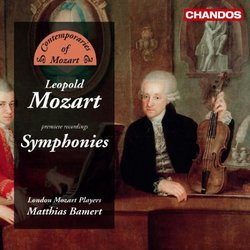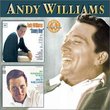| All Artists: London Mozart Players, Bamert Title: Leopold Mozart: Symphonies (premiere recordings) Members Wishing: 1 Total Copies: 0 Label: Chandos Original Release Date: 1/1/2008 Re-Release Date: 11/18/2008 Genre: Classical Style: Symphonies Number of Discs: 1 SwapaCD Credits: 1 UPC: 095115149621 |
Search - London Mozart Players, Bamert :: Leopold Mozart: Symphonies (premiere recordings)
 | London Mozart Players, Bamert Leopold Mozart: Symphonies (premiere recordings) Genre: Classical |
Larger Image |
CD DetailsSimilar CDs |
CD ReviewsDoing Justice to Leopold Mozart, the Symphonist M. C. Passarella | Lawrenceville, GA | 01/14/2009 (5 out of 5 stars) "While I haven't been collecting the Contemporaries of Mozart series religiously, releases that it's been my fortune to grab (Krommer, Hoffmeister, Pleyel, Gossec) have all been top-flight productions. So, too, with the current disc. Leopold Mozart may be known chiefly as the father and mentor of son Wolfgang, but in his own day he was highly regarded as a violin virtuoso and teacher and composer of the first rank. As a composer, today he is remembered for his charming entertainments, or cassations, such as the Toy Symphony and Musical Sleigh Ride. But his contemporaries thought of him as a composer of symphonies; he penned more than 70.
The works on the present disc, all supposedly first recordings, show the broad range of Mozart's symphonic achievement. The earliest works (C 1, D 1, C 4) have some of the static quality of Rococo entertainment music, as well as minimal orchestral gestures, hinting at the near interchangeability of chamber and symphonic music at the beginning of the Classical Era. On the other hand, the finest of the lot, D 17 and D 25, are commanding little works, probably the equal of any Haydn symphony from the 1760s. The Presto finale of D 17 is an especially unbuttoned affair, featuring jittery string figures and braying horns that evoke the hunt. The finales are generally the most striking movements, including the lightly dancing, fugal finale of G 14. All are sunny works--there's not a minor-key movement in the lot--but all display good workmanship, a good ear for sonorities, and an attempt at least to offer memorable melodies and episodes. They'll leave you smiling and, unless I miss my guess, respectful of Mozart's craft. The Mozart Chamber Players, on modern instruments, bring the best of 18th-century performance practice to their readings, especially those horns, which Mozart really puts through their paces. The horn players manage an appealingly clangorous, brazen quality that the composer would have undoubtedly admired. The recording, made in a church, is nonetheless immediate and impactful, imparting a nice sheen to the strings. This is a worthy addition to an important series. " |




